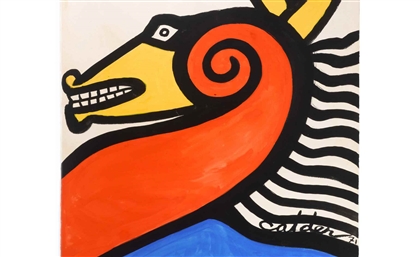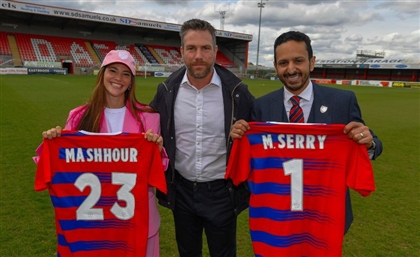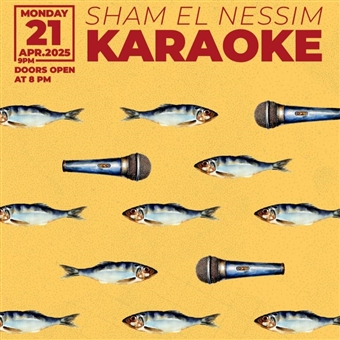Moataz Nasr: Coming Home
After a ten year absence from the Egyptian arts scene, founder of Darb 1718 Moataz Nasr is back with a collection of paintings at Art Talks that chronicles his emotional buildup in the period leading up to the exhibition.
Last Tuesday, veteran Egyptian artist and founder of Darb 1718 Moataz Nasr launched his first solo exhibition in Egypt in over ten years at Art Talks gallery in Zamalek. Untitled features a selection of Nasr's paintings that spans across the ten year period during which he was absent from the Cairene art scene, and beyond, but which are all drawn together by a common theme or mood.
And despite being painted at different instances over a period that spanned more than a decade, there is a continuity in the aesthetics from the paintings that stems from a similarity in the colour palette and textures of the different pieces.
"The works may have been created years apart, but they were all created in the same mental state," Nasr says of the collection. "I chose a selection of paintings which used a lighter, happier colour scheme because I wanted people to be joyous when they saw them. Everyone's carrying so many burdens and things have gotten so heavy, so I chose a direction that's joyous because in the midst of making political statement, I also wanted people to leave with good vibes and good energy."

Indeed, the overarching theme of the paintings does induce a sense of optimism. But the paintings are hardly limited to this as a theme. Many speak of a layering of experience that progresses in a trajectory that can be traced chronologically from the older paintings to the more recent of them.
"The whole idea is based on the abstract. There are no figures, I try to avoid that," Nasr says. "I'm working with the visual archive that I have. From people, from memories, from streets I've walked in, and the overall texture that Cairo has that is always changing. The idea that the streets themselves have memories. There are colours on top of colours, and then suddenly a wall will fall and you can see the old colours that wants to come out and breathe. At the same time, there's a harmony that comes from putting objects together that have no connection. Lines and colour and space."
But aside from the large collection of abstract paintings on display at the exhibition, one piece reigns above all the others: an installation of super-sized Islamic prayer beads made entirely out of butane gas cylinders.

"It's what we're living now, what's happening now in the Middle East, in terms of the interference of petrol and gas in religion in a very brutal manner, and the conditions created in the Middle East, which are all the result of money games - specifically oil money," Nasr says.
The installation piece serves as a form of direct political commentary on the current circumstances facing this part of the world, as does much of Nasr's more recent work, in which he mainly focuses on installations.
This particular piece is a far cry from the abstract "joyous" paintings that otherwise feature in the exhibition, and marks a major breaking point in his approach to art.
The stark socio-political commentary of the piece is characteristic of his installations, whereas his paintings lend themselves to a different, more personal approach. "Usually I don't give titles to my paintings. I want people to see and feel what I'm doing. I don't want to guide them. The name usually guides you to certain things, and I don't want to do that.
"I give my installations names because it's more 3D and it has a presence. Most of my installations are usually social or political, and I'm trying to make a statement [with them], so I usually give them names.
"There's a possibility for paintings to [make socio-political commentary], but paintings, no matter what, stop at two dimensions. But with an installation, I put objects inside and I impose it on you. It's immediate impact on the viewer is stronger, and so it's statements are more effective," Nasr says.

But while Nasr is consistently creating installations the world over, he nonetheless continuously returns to his paintings, describing it as a very personal process, which his own Sufistic tendencies and personal experience plays into. For Nasr, painting is as much a subconscious process as it is a therapeutic one, and the basis for all his art is the underlying need to express and expel the emotional and philosophical buildup of his life.
"When I work, I learn more things about myself and what I am, and how I think, and there's definitely a political side to my work, a social side, and even a Sufi side. All of that affects my work. I can't make clear lines between them," he says.
"I can just hope that what I'm trying to say is understood. For me, it's fine that it's open to interpretation. I draw and paint to inspire people and make them think and feel, and show that they can pull up something from inside themselves."
In that sense, the collection figures as a subconscious retelling of a psychological buildup that has been archived over the years, chronicling his own responses to the unfolding of events, both in his personal life and in the public sphere.
Despite the similarity in the colour palette, one can note a change in tone in the paintings, and his more recent works betray a sobriety that suggests that recent events have belied his process of production.

"When I'm working I don't think about what I'm doing before I start. I think about it later on. When I start, I'm simply trying to put my feelings out somewhere," Nasr says. "I expel everything and breathe."
Nasr currently has four exhibitions coming up abroad in the near future, but is also working on a collaborative project with a small group of artists locally, which incorporates artists in different fields with different techniques.
The exhibition at Art Talks continues until October 14.
- Previous Article Khadafi Fried Chicken: KFC Launches in Libya
- Next Article Nomades Land































